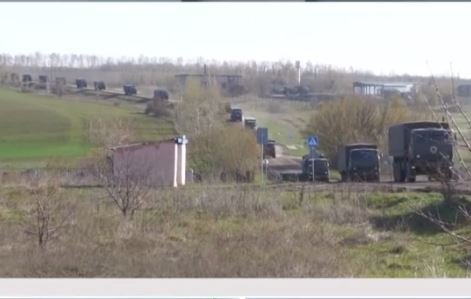Understanding the NY Times Article on the CIA in Ukraine
Understanding the NY Times Article on the CIA in Ukraine

When you read some so-called bombshell report dishing the dirt on some Top Secret U.S. operation in the New York Times or the Washington Post, you need to understand that this was not the result of some intrepid, eager beaver reporter who took the initiative and came up with a nifty idea for a story. Such stories are based on official or sanctioned leaks and always have an ulterior motive. This is not so much about informing an ignorant public about reality, rather it is either propaganda or signalling a shift in U.S. policy.
The New York Times published such a piece today under the title, Commando Network Coordinates Flow of Weapons in Ukraine, Officials Say. Ooohhh! Commando Networks. Sounds sexy and sinister:
As Russian troops press ahead with a grinding campaign to seize eastern Ukraine, the nation’s ability to resist the onslaught depends more than ever on help from the United States and its allies — including a stealthy network of commandos and spies rushing to provide weapons, intelligence and training, according to U.S. and European officials.
Much of this work happens outside Ukraine, at bases in Germany, France and Britain, for example. But even as the Biden administration has declared it will not deploy American troops to Ukraine, some C.I.A. personnel have continued to operate in the country secretly, mostly in the capital, Kyiv, directing much of the vast amounts of intelligence the United States is sharing with Ukrainian forces, according to current and former officials.
At the same time, a few dozen commandos from other NATO countries, including Britain, France, Canada and Lithuania, also have been working inside Ukraine. The United States withdrew its own 150 military instructors before the war began in February, but commandos from these allies either remained or have gone in and out of the country since then, training and advising Ukrainian troops and providing an on-the-ground conduit for weapons and other aid, three U.S. officials said.
I want to ensure you understand the first key “talking point”–the C.I.A. is still in Ukraine and working with both Ukrainian military and intelligence services “directing vast amounts of intelligence.” This totally destroys any claim that the United States Intelligence Community does not know what is the true status and operational capability of the Ukrainian Army. You see, if you are passing intel to the Ukrainians you are also in a position to glean what they are capable of doing with such information.
Let me give you an example. Let’s say that the CIA bubba in Kiev gets word that Russians are massing 5 Battlion Tactical Groups northeast of Mariupol. Mr. CIA gives that intel, with precise geographic coordinates to his Ukrainian counterpart. One would expect the Ukrainians to launch some sort of attack with fixed wing aircraft or missiles or artillery or armored units on that Russian force. In the real case of Mariupol, Ukraine failed to stop the Russian offensive and the city was captured, along with 2500 members of Ukraine’s AZOV Battalion.
At that point, Mr. CIA bubba has to report back to headquarters in McLean, Virginia why Ukraine failed to act on the intelligence. Was it because the intel was wrong? Was it because Ukraine ignored the intel? Or was it because Ukraine had no operational resources capable of acting on that intel? Regardless of the answer, the information flowing back to CIA Headquarters is supposed to give the analysts some evidence for drawing conclusions about the failure to act on that intelligence.
The next critical talking point in the NY Times piece concerns the news that U.S. special forces and special operations forces supposedly are not operating in Ukraine. We have left that dirty, dangerous work to commandos from Britain, France, Canada and Lithuania.
But all of this is window dressing to distract from the real news in the NY Times piece. It is in the last five paragraphs of the article:
The Ukrainian military’s most acute training problem right now is that it is losing its most battle-hardened and well-trained forces, according to former American officials who have worked with the Ukrainians.
The former Trump administration official said Special Operations Command had small groups of American operators working in the field with Ukrainian officials before the war. The American teams were sometimes called Jedburgh, a reference to a World War II effort to train partisans behind enemy lines, the official said.
The modern special operations teams mainly focused on training in small-unit tactics but also worked on communications, battlefield medicine, reconnaissance and other skills requested by Ukrainian forces. Those efforts, the official said, ended before the Russian invasion but would have been helpful if they had continued during the war.
Having American trainers on the ground now might not be worth the risks, other former officials said, especially if it prompted an escalation by President Vladimir V. Putin of Russia.
“Would the enhancement of the training be worth the possible price that is going to have to be paid?” Mr. Wise said. “An answer is probably not.”
Got that? The most acute problem is that the best Ukrainian troops are dead, wounded or captured. There are no first rate troops left to train. Oh my. That is a problem and the United States is not going to put any of our troops into harms way. That is, for now, the Biden Administration’s policy. Putting “modern special operations teams” on the ground to train Ukrainians is, per the NY Times piece, too great a risk and carries a price that is not worth the outcome.
The post Understanding the NY Times Article on the CIA in Ukraine appeared first on The Gateway Pundit.
Go to Source
Author: Larry Johnson

